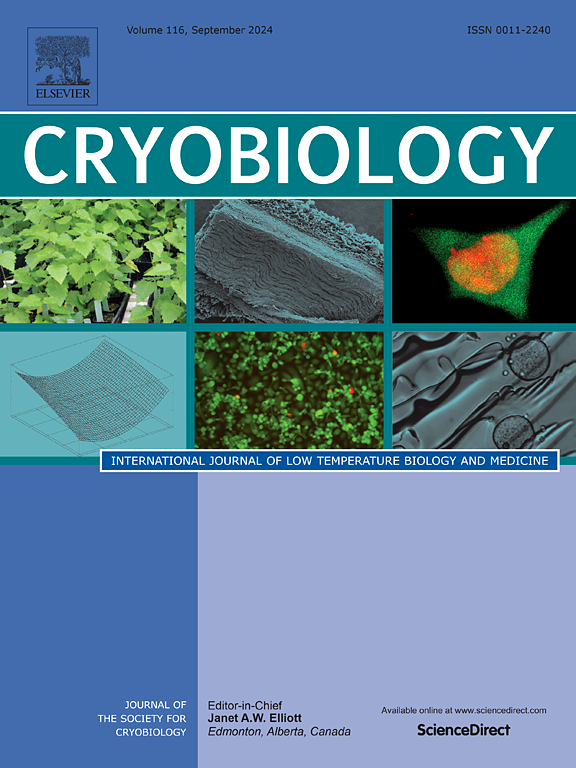An efficient and convenient method for the preservation of germplasm resources: Cryopreservation of mature testis of large yellow croaker (Larimichthys crocea)
IF 2.1
3区 生物学
Q2 BIOLOGY
引用次数: 0
Abstract
Large yellow croaker (Larimichthys crocea) is one of the most important marine economic fish. However, due to overfishing and long-term artificial breeding, the germplasm has degraded in recent years, and the wild germplasm has been listed as critically endangered. It is urgent to protect the germplasm resources of Larimichthys crocea. Cryopreservation may be an alternative way, however, the toxicity of cryoprotectants and the complicated preservation procedure that uses a programmable freezer has greatly increased the difficulty of cryopreservation. Therefore, in this study, we aimed to explore an efficient, convenient, inexpensive and low toxicity method for cryopreservation of mature testes in this species. The cryoprotectants of dimethyl sulfoxide (Me2SO), ethylene glycol (EG), propylene glycol (PG) were selected to cryopreserve the mature testes with liquid nitrogen in simple style. Finally, the testes were cut into blocks (1.0 cm3) with cryoprotectants of 20 % PG and 15 % Me2SO, placed at a position 10 cm above the liquid nitrogen for 10 min, then plunged into liquid nitrogen, resulting in high survival rate of 64.17 % at 3 days post cryopreservation. And the recovery rate of spermatogonia was more than 70 %. Subsequently, the cells viability were further detected by qRT-PCR, in situ hybridization (ISH) and germ cell transplantation. These results suggested that the spermatogonia from cryopreserved testes had high viability, which could migrate and colonized after transplantation. The present study first established cryopreservation protocols of mature testis in Larimichthys crocea, which will serve as a promising tool to protect Sciaenidae and other fish germplasm resources.
一种高效简便的种质资源保存方法——大黄鱼成熟睾丸的低温保存
大黄鱼(Larimichthys crocea)是重要的海洋经济鱼类之一。然而,由于过度捕捞和长期的人工繁殖,近年来种质资源已经退化,野生种质已被列为极度濒危物种。保护大鲵种质资源刻不容缓。冷冻保存可能是一种替代方法,然而,冷冻保护剂的毒性和使用可编程冷冻机的复杂保存程序大大增加了冷冻保存的难度。因此,在本研究中,我们旨在探索一种高效、方便、廉价、低毒的成熟睾丸冷冻保存方法。选择二甲亚砜(Me2SO)、乙二醇(EG)、丙二醇(PG)作为冷冻保护剂,用液氮对成熟睾丸进行简易冷冻保存。最后,用20% PG和15% Me2SO的冷冻保护剂将睾丸切成块状(1.0 cm3),放置在液氮上方10 cm处10分钟,然后放入液氮中,冷冻保存3天后存活率高达64.17%。精原细胞恢复率达70%以上。随后,采用qRT-PCR、原位杂交(ISH)和生殖细胞移植检测细胞活力。这些结果表明,低温保存的睾丸精原细胞具有较高的活力,移植后可迁移和定植。本研究首次建立了鲈鱼(Larimichthys crocea)成熟睾丸的冷冻保存方法,为鱼科及其他鱼类种质资源的保护提供了一种有前景的手段。
本文章由计算机程序翻译,如有差异,请以英文原文为准。
求助全文
约1分钟内获得全文
求助全文
来源期刊

Cryobiology
生物-生理学
CiteScore
5.40
自引率
7.40%
发文量
71
审稿时长
56 days
期刊介绍:
Cryobiology: International Journal of Low Temperature Biology and Medicine publishes research articles on all aspects of low temperature biology and medicine.
Research Areas include:
• Cryoprotective additives and their pharmacological actions
• Cryosurgery
• Freeze-drying
• Freezing
• Frost hardiness in plants
• Hibernation
• Hypothermia
• Medical applications of reduced temperature
• Perfusion of organs
• All pertinent methodologies
Cryobiology is the official journal of the Society for Cryobiology.
 求助内容:
求助内容: 应助结果提醒方式:
应助结果提醒方式:


